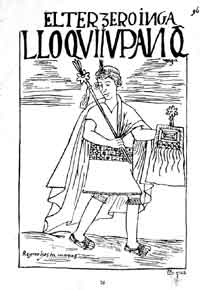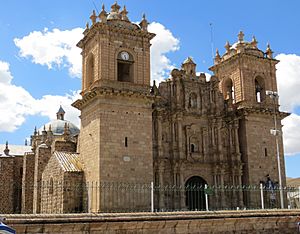Ayaviri, Melgar facts for kids
Quick facts for kids
Ayaviri
Ayawiri
|
|
|---|---|
|
Village
|
|

Ayaviri panorama
|
|
| Country | |
| Region | Puno |
| Province | Melgar |
| District | Ayaviri |
| Elevation | 3,907 m (12,818 ft) |
| Population | |
| • Estimate
(2015)
|
20,152 |
| Time zone | UTC-5 (PET) |
| Website | http://www.munimelgar.gob.pe/ |
Ayaviri, also known as Ayawiri in the Aymara language, is a town in southern Peru. It is the capital of the Melgar Province in the Puno Region. In 2007, about 22,667 people lived in Ayaviri.
The town celebrates a few special events. The Festividad de Calendaria happens on January 24. The Aniversario de la Provincia is celebrated on October 25.
Contents
What Does the Name Ayaviri Mean?
The exact meaning of the name "Ayaviri" is a bit of a mystery. Experts look at old languages spoken in the area to figure it out. These languages include Urikuilla, Pukina, and Aymara. Even though Quechua is spoken there now, it came later.
Urikuilla Language Meanings
In Urikuilla, the word ayawiri means "the place where reeds grow." Reeds are tall grass-like plants. Even if you don't see many reeds there today, the area used to have a lot of them.
Pukin Language Meanings
In Pukin, ayaviri can mean "the farm of the children." It can also mean "the place for children's farms." Another similar word, hayaviri or jayaviri, means "the place where young men cultivate land." This fits with an old tradition. Sons in families would inherit the right to farm certain lands each year.
Aymara Language Meanings
The Aymara language gives us many possible meanings for Ayaviri.
- Ayawiri can mean "to spin" or "the spinners." It might also mean "the place where spinners live." This meaning could be linked to old spinning mills in the town. These mills used wool from local animals to make yarn and cloth. They were destroyed in 1781 during a big rebellion.
- Another word, aywiri, means "men who march closely together." This can mean "an army with many soldiers."
- Hayaviri or jayaviri can mean "a distant place" or "a border town." It can also mean "people who live far away." In a military sense, it can mean "men marching ahead" or "the front line of an army."
- A similar word, hayahiwiri or jayahiwiri, means "General Commander of the Aymaran armies." It can also mean "immortal" or "champion."
- The word hayahawiri means "the river that comes from far away." This probably refers to the river south of Ayaviri.
Quechua Language Meanings
Even though Quechua came to the region later, it's still important. Many locals today might understand the name through Quechua.
- Some say ayaviri in Quechua means "soldier" or "military." It could also mean "a meeting place for many armies."
- Another word, ayuiri or awiri, also means "soldier." It can also mean "added," "joined," or "reunited."
- The word aya in Quechua means "dead body" or "corpse." If you add huayra or wayra (meaning "wind"), it becomes "wind of the dead." This might relate to the many tombs found around the town long ago.
Ayaviri's History
Early People of Ayaviri
According to an old writer named Pedro Cieza de León, the first people in Ayaviri were related to the Canas tribe. He described them as "proud, careful, and a bit sad." They often wore dark clothes. They were also said to be stronger and darker-skinned than their neighbors, the Canches, with whom they often fought.
The Inca Conquest
We learn about the Inca conquest of Ayaviri from writers like Pedro Cieza de León and Garcilaso de la Vega. The conquest happened under Inca Lloque Yupanqui. It seems there were many battles before Ayaviri's people joined the Inca Empire.
Garcilaso de la Vega says the people of Ayaviri fought very hard. They wanted to die fighting for their freedom rather than give up. Both sides lost many people. But the Inca ruler brought in many more soldiers. The people of Ayaviri had to surrender. Cieza de León wrote that they "suffered so much that they gave up."
After the conquest, Inca Lloque Yupanqui ordered many buildings to be built. These included a palace and a temple for the sun god. He also brought in new families, called mitimae, to live in the town. They would farm the land and take the place of the people who had died. This way, Ayaviri became a full part of the Tahuantinsuyo. Its people and economy were now under Inca control.
During Spanish Rule
The Spanish took control of Ayaviri after conquering Cuzco. In 1535, Diego de Almagro passed through Ayaviri on his way south. The land was given to Francisco Villacastín in 1543. He was the first encomendero (a Spanish person given control over land and people) of Ayaviri. Soon after, around 1545, Juan de Pancorbo became the new encomendero.
These land divisions also created church areas called doctrinas. The church area of Ayaviri was set up in 1565. It was part of the Lampa Province, which was under the Bishopric of Cuzco.
The region was known for having many animals, especially livestock. Even today, the province is called the "livestock capital of Peru." This was very important for Ayaviri's economy. The encomienda and estancia (large farms) systems helped develop these resources.
Role in Early Rebellions
Ayaviri played a part in several uprisings before Peru gained independence from Spain.
- Hundreds of local people from Ayaviri joined the rebellion in 1771. This rebellion was a warm-up for the more famous rebellion of Tupac Amaru II.
- When Tupac Amaru II and his army visited Ayaviri in 1780, they were welcomed. This led to a lot of damage to churches and other buildings.
- Ayaviri also strongly supported the second part of this rebellion.
- In 1815, Ayaviri was a camp for leaders like Angulo and Mateo Pumacahua before a major battle.
While many people in Ayaviri supported these uprisings, some sources say that not everyone agreed. Some historians suggest that the people of Ayaviri actually captured Pumacahua. They then handed him over for punishment. This shows that people in Ayaviri, like in any community, had different ideas about these rebellions.
Religion in Ayaviri
Catholic Faith
Most people in Ayaviri are Catholic. This has been true since the Spanish arrived.
The Cathedral of Saint Francis of Assisi is in the main square, the Plaza de Armas. It is the oldest building in Ayaviri and a symbol of the strong Catholic faith there. It was built around the late 1600s. The cathedral is a great example of Andean Baroque art and architecture. It shows the style of the Cuzco school.
The cathedral and the plaza have always been central to celebrations and gatherings. Many of these events are religious. In 1958, when the Territorial Prelature of Ayaviri was formed, the cathedral became its main church.
People in Ayaviri show their faith in many colorful ways. Here are some important religious celebrations:
| Date | Celebration | Details |
|---|---|---|
| 3 May | Festival of the Cross of Kolqueparque | This festival starts with a candlelit vigil in the evening. Masses and processions follow in the next few days. The whole region celebrates this festival throughout May, but each town has different dates. |
| 17 July | Our Lady Queen of Peace | |
| 6 August | Virgin of Copacabana | A Mass and procession take place. Cars are also blessed on this day. |
| 8 August | St. Rose of Lima | She is the patron saint of Peru. |
| 7-15 September | Our Lady of High Grace | This is a nine-day celebration with Masses and processions. Our Lady of High Grace is very important to the people of Ayaviri. |
| 4 October | St. Francis of Assisi | Franciscans were important in bringing Christianity to the area. The cathedral is named after St. Francis, so he is special to the locals. |
| 28 October | Lord of Miracles | This is a very popular religious event all over Peru. |
Climate
| Climate data for Ayaviri, elevation 3,941 m (12,930 ft), (1991–2020) | |||||||||||||
|---|---|---|---|---|---|---|---|---|---|---|---|---|---|
| Month | Jan | Feb | Mar | Apr | May | Jun | Jul | Aug | Sep | Oct | Nov | Dec | Year |
| Mean daily maximum °C (°F) | 16.3 (61.3) |
16.3 (61.3) |
16.4 (61.5) |
16.8 (62.2) |
17.0 (62.6) |
16.3 (61.3) |
16.3 (61.3) |
17.4 (63.3) |
18.6 (65.5) |
18.7 (65.7) |
19.0 (66.2) |
17.8 (64.0) |
17.2 (63.0) |
| Mean daily minimum °C (°F) | 3.8 (38.8) |
3.8 (38.8) |
3.1 (37.6) |
0.9 (33.6) |
−3.5 (25.7) |
−6.3 (20.7) |
−6.4 (20.5) |
−4.6 (23.7) |
−1.0 (30.2) |
1.0 (33.8) |
2.0 (35.6) |
3.2 (37.8) |
−0.3 (31.4) |
| Average precipitation mm (inches) | 135.5 (5.33) |
123.5 (4.86) |
102.3 (4.03) |
40.1 (1.58) |
7.2 (0.28) |
3.3 (0.13) |
2.7 (0.11) |
6.9 (0.27) |
13.6 (0.54) |
45.8 (1.80) |
60.1 (2.37) |
89.8 (3.54) |
630.8 (24.84) |
| Source: National Meteorology and Hydrology Service of Peru | |||||||||||||
See also
 In Spanish: Ayaviri (Melgar) para niños
In Spanish: Ayaviri (Melgar) para niños





